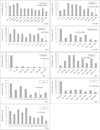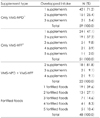1. Bailey RL, Gahche JJ, Lentino CV, Dwyer JT, Engel JS, Thomas PR, Betz JM, Sempos CT, Picciano MF. Dietary supplement use in the United States, 2003-2006. J Nutr. 2011; 141(2):261–266.

2. Block G, Jensen CD, Norkus EP, Dalvi TB, Wong LG, McManus JF, Hudes ML. Usage patterns, health, and nutritional status of long-term multiple dietary supplement users: a cross-sectional study. Nutr J. 2007; 6:30.

3. Kim SH, Han JH, Kim WY. Health functional food use and related variables among the middle-aged in Korea. Korean J Nutr. 2010; 43(3):294–303.

4. Kim SH, Lee SH, Hwang YJ, Kim WY. Exposure assessment of vitamins and minerals from various sources of Koreans. Korean J Nutr. 2006; 39(6):539–548.
5. Murphy SP, White KK, Park SY, Sharma S. Multivitamin-multimineral supplements' effect on total nutrient intake. Am J Clin Nutr. 2007; 85(1):280S–284S.
6. Han JH, Kim SH. Behaviors of vitamin, mineral supplement usage by healthy adolescents attending general middle or high schools in Korean. Korean J Nutr. 2000; 33(3):332–342.
7. Merkel JM, Crockett SJ, Mullis R. Vitamin and mineral supplement use by women with school-age children. J Am Diet Assoc. 1990; 90(3):426–428.

8. Walter P. Towards ensuring the safety of vitamins and minerals. Toxicol Lett. 2001; 120(1-3):83–87.

9. Timbo BB, Ross MP, McCarthy PV, Lin CT. Dietary supplements in a national survey: prevalence of use and reports of adverse events. J Am Diet Assoc. 2006; 106(12):1966–1974.

10. Yang JK, Kim SH. Patterns of fortified food use among teenagers in Chungnam province and Daejeon city in Korea. Korean J Food Cult. 2004; 19(4):447–459.
11. Brown A. Chemistry of food composition. In : Brown A, editor. Understanding Food: Principles and Preparation. Belmont (CA): Wadsworth;2000. p. 43–46.
12. Han JH, Kim SH. Vitamin, mineral supplement use and related variables by Korean adolescents. Korean J Nutr. 1999; 32(3):268–276.
13. Kim SH, Keen CL. Patterns of vitamin/mineral supplement usage by adolescents attending athletic high schools in Korea. Int J Sport Nutr. 1999; 9(4):391–405.

14. Kim SH, Keen CL. Vitamin and mineral supplement use among children attending elementary schools in Korea: a survey of eating habits and dietary consequences. Nutr Res. 2002; 22(4):433–448.

15. Kim SH, Han JH, Hwang YJ, Kim WY. Use of functional foods for health by 14-18 year old students attending general junior or senior high schools in Korea. Korean J Nutr. 2005; 38(10):864–872.
16. Kim SH, Han JH, Zhu QY, Keen CL. Use of vitamins, minerals, and other dietary supplements by 17- and 18-year-old students in Korea. J Med Food. 2003; 6(1):27–42.

17. The Korean Nutrition Society. Dietary reference intakes for Koreans. Seoul: The Korean Nutrition Society;2005.
18. Yakup Newspaper. Korean drug index. Seoul: Yakup Newspaper;2009.
19. Budarari S, O'Neil MJ, Smith A, Heckslman PE. The Merck Index: an encyclopedia of chemicals, drugs and biologicals. 11th edition. Rahway (NJ): Merck & Co.;1989.
20. David WH, Peter AM, Victer WR, Daryl KG. Harpe's review of biochemistry. 30th edition. Los Altos (CA): Lange Medical Publications;1995.
21. Korea Food and Drug Administration. Tolerable upper intake levels for vitamins and minerals in functional foods for health (II). Seoul: Korea Food and Drug Administration;2005.
22. National Rural Living Science Institute (KR). Food composition. Suwon: National Rural Living Science Institute;2001.
23. The Korean Nutrition Society. Dietary reference intakes for Koreans. Seoul: The Korean Nutrition Society;2010.
24. Expert Group on Vitamins and Minerals (UK). Safe upper levels for vitamins and minerals. London: Food Standard Agency;2003. p. 52–61.
25. Institute of Medicine (US). Dietary reference intakes for vitamin C, vitamin E, selenium, and carotenoids. Washington, D.C.: National Academy Press;2000.
26. Institute of Medicine (US). Dietary reference intakes for vitamin A, vitamin D, arsenic, boron, chromium, copper, iodine, iron, manganese, molybdenum, nickel, silicon, vanadium, and zinc. Washington, D.C.: National Academy Press;2001.
27. Rock CL. Multivitamin-multimineral supplements: who uses them? Am J Clin Nutr. 2007; 85(1):277S–279S.

28. Stang J, Story MT, Harnack L, Neumark-Sztainer D. Relationships between vitamin and mineral supplement use, dietary intake, and dietary adequacy among adolescents. J Am Diet Assoc. 2000; 100(8):905–910.

29. Radimer K, Bindewald B, Hughes J, Ervin B, Swanson C, Picciano MF. Dietary supplement use by US adults: data from the National Health and Nutrition Examination Survey, 1999-2000. Am J Epidemiol. 2004; 160(4):339–349.

30. Fulgoni VL 3rd, Keast DR, Bailey RL, Dwyer J. Foods, fortificants, and supplements: Where do Americans get their nutrients? J Nutr. 2011; 141(10):1847–1854.

31. Butte NF, Fox MK, Briefel RR, Siega-Riz AM, Dwyer JT, Deming DM, Reidy KC. Nutrient intakes of US infants, toddlers, and preschoolers meet or exceed dietary reference intakes. J Am Diet Assoc. 2010; 110:12 Suppl. S27–S37.

32. Korea Centers for Disease Control and Prevention. Korea Health Industry Development Institute. In-Depth Analysis on the 3rd (2005) Korea Health and Nutrition Examination Survey -Nutrition Survey-. Seoul: Korea Centers for Disease Control and Prevention;2007. p. 341–343.
33. Kloosterman J, Fransen HP, de Stoppelaar J, Verhagen H, Rompelberg C. Safe addition of vitamins and minerals to foods: setting maximum levels for fortification in the Netherlands. Eur J Nutr. 2007; 46(4):220–229.

34. Verkaik-Kloosterman J, McCann MT, Hoekstra J, Verhagen H. Vitamins and minerals: issues associated with too low and too high population intakes. Food Nutr Res. 2012; 56:5728.













 PDF
PDF ePub
ePub Citation
Citation Print
Print


 XML Download
XML Download